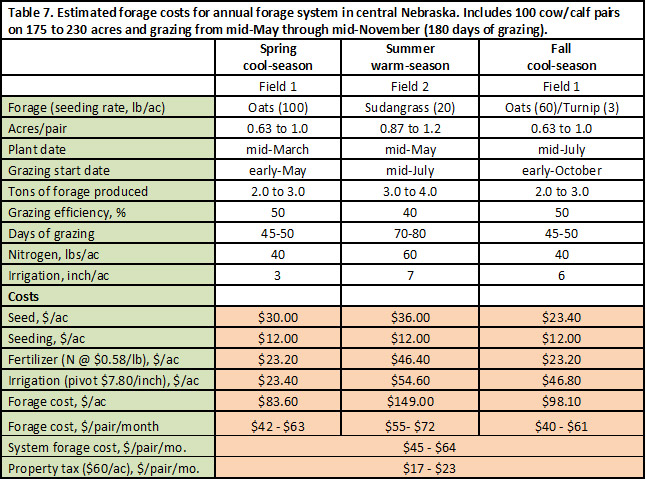Planning Annual Forage Systems
page 4
March 2016
Potential Forage-related Cattle Disorders
Prussic-acid poisoning can occur with sudangrass and sorghum-sudangrass hybrids. However, certain varieties of sudangrass or sorghum-sudangrass hybrids are known to be lower in prussic acid potential than others. Therefore, it is best to select varieties that are known to have low potential for the production of prussic acid and not begin grazing until plants have reached target height of 18 to 24 inches. When grazing in late fall, care must be taken to remove cattle from prussic-acid producing species before frost. Grazing can resume 10 days after a hard-killing frost. For more information see NebGuide G2184, Cyanide Poisoning (PDF version, 463KB).
Nitrate poisoning can be an issue with all annual grasses, as well as with brassicas, and usually occurs when high rates of nitrogen fertilizer are used in one application or when factors such as detrimental weather interfere with plant growth. For more information, see NebGuide G1779, Nitrates in Livestock Feeding (PDF version, 319KB).
When grazing small grains in the spring or fall, grass tetany is a concern for lactating cows. Feeding a free-choice mineral that has 12 to15 percent magnesium with a target intake of 3 to 4 ounces/d will reduce the incidence of grass tetany.
Despite the potential for forage toxicity, both the summer and winter annual forages offer opportunities for economical forage production.
Cost of Forage Production
Table 7 (below) provides an example of a system following the plan illustrated in System A (Table 1, above) with an estimate of costs for producing the forage. Table 8 (below) provides an example of a system following the plan illustrated in System B (Table 2, above). The system in Table 7 requires more land per pair but has less input costs compared to the system in Table 8.
Current pasture rental prices in the center part of Nebraska average $62/pair/month and ranges from $48 to $83/pair/month. Current pasture rental rates are at high enough levels to suggest there may be an opportunity to use annual forage systems economically. However, this will vary significantly across regions and specific operations. Thus, producers need to take a serious look at their own situation before incorporating this sort of change into their operation.


Page 1 | Page 2 | Page 3 | Page 4 || View all
Jerry D. Volesky
Range and Forage Specialist
Nebraska Extension
Mary E. Drewnoski
Beef Systems Specialist
Nebraska Extension